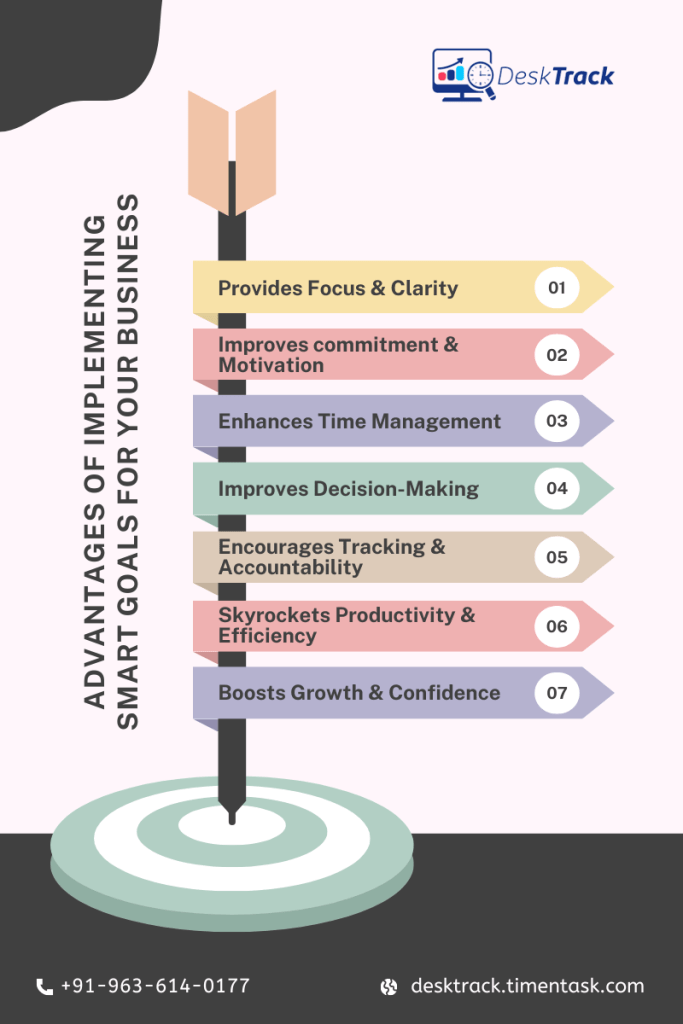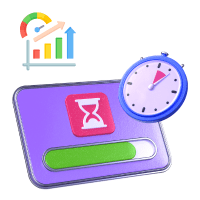
Do you want to know everything there is to it to set SMART goals for your business? You are browsing the right page. Speaking about goals, they drive our ambitions, shape our futures, and make us move forward towards success. However, without a transparent framework, even the most well-intentional objectives can become incomprehensible and unachievable.
That’s why everyone on your team must know how to configure objectives. However, we must do it the SMART way. These types of objectives offer you a structured approach to goal setting. This converts uncertain ideas into clear plans. Overall, this way, the chances of reaching the goals increase.
However, why do SMART goals work while other techniques fail? In today’s blog post, we will uncover the secret behind this and many more useful insights to help your business achieve success. Plus, we will also reveal the software we use to track our SMART objectives.
What are SMART Goals?
Did you know that 43% of people who set goals achieve them? SMART is not a term. However, it’s an acronym that taught us and will teach you how to set and achieve your goals most effectively. Here, SMART expands to specific, measurable, achievable, relevant, and time-bound:
1. Specific
The goal must be clear-cut and focused, answering the who, what, where, when, and why. For example, instead of improving your skills, it’s better to complete an advanced Excel course to enhance your data analysis capabilities for your current designation in finance.
2. Measurable
This involves ensuring that you can monitor progress and identify when you have achieved your objective. We recommend keeping the metrics quantifiable for this one. For example, boosting your typing speed from 50 words per minute to 75 words per minute within the next 3 months.
3. Achievable
We agree that goals must be challenging, but they must also not take a toll on your mental health. The objectives must be realistic based on your resources and situation. Overall, the goal must push your limits without sending failure your way. To give you an example, saving $5000 for the down payment on a new house by reducing your monthly expenses by $300 and accepting 2 freelance projects.
4. Relevant
The next thing to remember is that your goals must also be aligned with the broader objectives of your organization and relevant to your long-term plans. Plus, it should matter to you and fit with other objectives as well. For example, networking with 20 more sector professionals this quarter to grow your career opportunities in marketing.
5. Time-Bound
To make every goal SMART, there must be a transparent deadline. What it does is create a sense of urgency, reducing distractions and procrastination. For example, aiming to launch your new video game by June 30. For this, you will dedicate 10 hours per week to its development.
Read Also: Best Ways to Boost the Work Performance of Your Employees in 2025
Why SMART Goals Work for Your Business?
So, why are SMART business goals effective? The reason behind them working every time is that these objectives provide you with a clear framework, pushing you and your employees to think critically about what you want and how you will achieve it. The goals:
- Transform abstract ideas into tangible targets.
- Replace unclear intentions with specific deadlines and measurable steps.
- Assist you in maintaining focus, tracking progress, and making adjustments as per your requirements.
7 Factors to Consider When Setting SMART Goals for Your Business

So, now you know what SMART is, we can move on to discussing how you can be smart while configuring your goals. You need to understand these 7 aspects first.
1. Intended Results
Intended results mean knowing what you want to achieve by focusing on measurement and objectives. The former is all about the practicality of the plan, while the latter includes knowing why you want to reach a particular goal.
2. Future Vision
A good tip to achieve your goals is to visualize them. Experts suggest that you mentally picture your future and jot it down. For an even better visualization of the workflow, we use screenshot monitoring software.
3. Skills
You also need to factor in your skills to configure practical objectives for yourself. Again, it’s a good idea to write down your skills and refer to them.
4. Resources
Writing down the resources available to you, planning how to use them to reach your goals becomes simple. The idea here is to separate your resources into two categories: people and assets. Overall, what you need to do is assign the right people to the right resources to ensure optimum utilization.
5. Milestones
Similar to how you can’t directly go from the first step to the top step, you can’t achieve all your goals with a jump. You need to divide the deadline into milestones or timelines. In other words, breaking down the complex project into small chunks or tasks. Overall, it helps you stay on track with your objectives.
6. Rewards
Don’t forget to reward yourself for achieving a milestone. Remember that overworking to accomplish all your objectives can and will lead to burnout. So, take short breaks to rejuvenate and relax whenever possible.
7. Action Plans
Now, to achieve our milestones, we can’t just create them and take no further steps. Doing so will lead us nowhere. Instead, what we need to do is make action plans regarding what we will do to reach every milestone.
5 Steps to Write a SMART Goal for Your Business
Below, we have broken down the process to write a business goal the smart way. As we mentioned before, switching to this method increases your chances of accomplishing your objectives to reach success:
1. Define the Goal
Your goal must be straight to the point. Here are a few things to consider.
- The aim of your goal
- The reason you are doing it
- The human resources involved
- The location of the goal
2. Ensure Progress Measurement
Next, you need to make solid criteria to achieve your goals. Tracking progress helps you and your teams stay on track and inspired to keep working. Here’s what you need to ask yourself.
- How much?
- How many?
- How will you know when it’s established?
3. Keep it Real
You also need to set up goals that are attainable. It helps you maintain motivation by assisting you in seeing progress via manageable steps. As we mentioned before, it boosts the chances of success, skyrockets productivity, and assists you in becoming more confident as you reach each milestone:
- Do you have the necessary resources and skills to accomplish this task?
- Is this goal realistic as per the constraints?
4. Make it Relevant
It’s also crucial to link your efforts to the wider objective. Plus, it should be aligned with other objectives and your organization’s bigger vision. Overall, the goal must matter to you and must be worthwhile:
- The goal must be worthwhile
- The time to start the goal must be appropriate
- The objective must match your other efforts or requirements
5. Make it Time-Bound
As we mentioned before, what it does is create a sense of urgency. It helps you prioritize your tasks better, thanks to a particular timeframe to achieve goals.
For example, days, weeks, or months. All you need to do is define a transparent timeframe and break down the goals into smaller tasks with sub-deadlines. Overall, having a deadline assists you in staying concentrated and inspired, as there is a fixed endpoint to work towards.
Furthermore, to boost the work-time utilization efficiency of your employees, we use time tracking software:
- The deadline by which the objective must be achieved
- The tasks that you will do today, next week, and next month to get closer to your goal
5 Examples of SMART Goals for Your Business
Make your workday more productive
Time tracking and work management can help you reach your goals
faster.
A good thing about SMART business goals is that they can be implemented across all your different teams and departments. Plus, regardless of the complexity of your objectives, you will surely achieve success. If you are SMART enough, that is. Get it? Nonetheless, here are 4 professional and 1 personal instances to give you a better understanding.
|
Specific: Increasing the organization’s market share by 5% in the next year by expanding the product line and enhancing the market efforts.
Measurable: Using quarterly sales reports and market analysis tools to measure market share. Achievable: Based on current market trends and the success of the recent product. Relevant: Boosting market share is essential for maintaining the organization’s competitive edge and driving revenue and growth. Time-Bound: The business will have increased its market share and achieved a stable YOY growth. |
|
Specific: Improving employee engagement by implementing a new internal communication platform and launching monthly team-building activities.
Measurable: Using biannual surveys and tracking participation rates in team-building activities to measure employee engagement. Achievable: Based on the budget allocated for employee engagement initiatives. Relevant: Skyrocketing employee engagement boosts productivity and decreases turnover rates. Time-Bound: The deadline is 6 months from now. |
|
Specific: Increasing the monthly sales revenue.
Measurable: Aiming to skyrocket sales by 20%. Achievable: Implementing a new marketing campaign and providing a limited-time discount to attract new customers. Relevant: Skyrocketing sales revenue is important for the growth and sustainability of the business. Time-Bound: The deadline is within the next quarter. |
|
Specific: Developing leadership skills by finishing an executive leadership course and mentoring 3 emerging leaders within the organization.
Measurable: Using completion of the course and feedback from mentees to measure the goal. Achievable: Based on the support from the organization and the time given for professional development. Relevant: Enhancing leadership skills is essential for succession planning to ensure the long-term success of the organization. Time-Bound: The will to see measurable improvements and get better feedback within 12 months. |
|
Specific: Turning a story idea into a novel.
Measurable: It must be at least 100000 words long, and at least 3 hours must be spent working on it daily. Achievable: The time to write it is in the evening. Being a reader and writer also helps, as you know what makes a compelling and good story. Relevant: Since reading and writing are your passions, it inspires you to become an author. Time-Bound: Begin writing in the first week of July. The first draft must be done by January. |
Read Also: All You Need to Know About Field Employee Tracking Apps in 2025
7 Advantages of Implementing SMART Goals for Your Business

Implementing SMART goals in your business will transform the way you and your employees work towards your goals. Trust us, it’s much streamlined, chaos-free, and lacks confusion, misunderstandings, and work rush. Moreover, here are 7 more benefits that await you.
1. Provides Focus & Clarity
You and your employees have everything you need to optimally work towards your goals, stay on track, and achieve success. When there is 100% clarity, the focus automatically increases, which skyrockets your work efficiency and productivity.
2. Improves commitment & Motivation
Thanks to the particularity and measurability of the goals, there is a sense of purpose, which leads to more commitment and motivation to keep working. These objectives provide you, your employees, and your teams with checkpoints, encouraging progress, establishing commitment, and instilling discipline.
3. Enhances Time Management
Thanks to the time-bound property of SMART, there will be no procrastination or similar issues, which boosts the chances of getting more success. Overall, what you are doing is setting a deadline and breaking the goals into manageable steps, which assists in improving task prioritization and time allocation.
4. Improves Decision-Making
When your goals are SMART, they properly align with the bigger picture. This makes it easy to get rid of distractions and concentrate on the work that matters. Overall, you will see impactful changes in decision-making.
5. Encourages Tracking & Accountability
Thanks to measurable outcomes and deadlines, your employees can’t blame each other in case of any delays or stalls. It enables regular progress tracking, allowing necessary adjustments when required, giving you a sense of accomplishment when you achieve milestones. However, we still use project management software for real-time and more precise progress tracking.
6. Skyrockets Productivity & Efficiency
By breaking down big goals into manageable steps, you also decrease your and your employees’ stress levels, workloads, and burden. When goals are SMART, they streamline efforts and prevent time-wasting.
7. Boosts Growth & Confidence
When you and your employees achieve small milestones to complete the bigger objectives step by step, every task completed builds your confidence in your skills. Plus, you grow as a team, focusing on work with more dedication, awaiting the next reward.
Effectively Manage Your SMART Goals with DeskTrack
Now that you have set up your SMART goals, you are good to go on the path to success, the better way. However, you still need something to track the progress and how your employees are working towards achieving the objectives. We don’t recommend manually doing it, as your time will be wasted, and there will be micromanagement and biased decisions, which are unethical and outdated. For precise results, try the all-in-one employee monitoring software, DeskTrack, to get real-time and precise insights into the goal progress. Know who is behind delays, how much more effort you need to put in, and much more with a click of a button. Use DeskTrack because you need a SMARTER tool to track your SMART objectives.
Frequently Asked Questions (FAQ)
Q. What are SMART Goals?
Ans. SMART is not a term. However, it’s an acronym that taught us and will teach you how to set and achieve your goals most effectively. Here, SMART expands to specific, measurable, achievable, relevant, and time-bound.
Q. What are the Benefits of Implementing SMART Goals?
Ans. Here are the advantages you get from implementing goals the SMART way.
- Provides Focus & Clarity
- Improves commitment & Motivation
- Enhances Time Management
- Improves Decision-Making
- Encourages Tracking & Accountability
- Skyrockets Productivity & Efficiency
- Boosts Growth & Confidence
Q. What are the 5 SMART Goals?
Ans. SMART expands to:
- Specific
- Measurable
- Achievable
- Relevant
- Time-bound.
Q. What are Some Examples of SMART Objectives?
Ans. Here are a few instances where SMART objective settings can be applied.
- Market Share
- Employee Engagement
- Sales
- Leadership
- Writing a Book
Q. What are the 7 Factors Needed to Establish SMART Goals?
Ans. Before establishing SMART objectives, you need to factor in your:
- Intended Results
- Future Vision
- Skills
- Resources
- Milestones
- Rewards
- Action Plans









